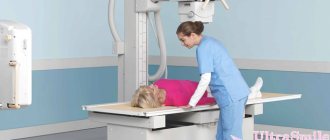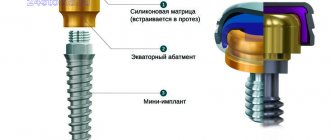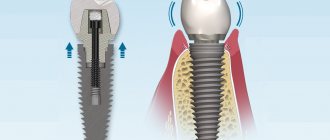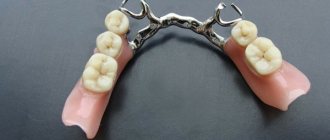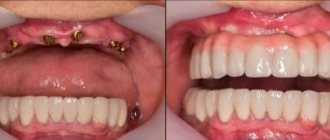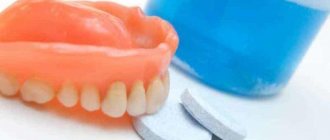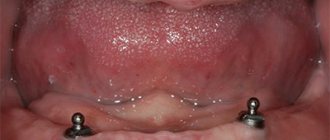What needs to be done to ensure that the dentures fit well and can be worn comfortably
Article navigation
- Why is it comfortable or uncomfortable to wear?
- - due to atrophy
- - due to poor quality manufacturing
- - due to breakdown
- If the bridge or crown becomes uncomfortable
- Solutions to the problem
- Preparation and diagnostics
- Correct manufacturing
- Fitting
- addictive
- Adjustment
- Fixation means
- When to repair and when to completely replace
- Alternative
Question for a specialist
Many clinics promise to supply comfortable removable dentures. But wearing them, as a rule, results in discomfort for patients. New artificial teeth can be uncomfortable initially – immediately after prosthetics. And they may become like this after some time. Fixed tooth replacement structures are very rarely uncomfortable. There are many reasons for discomfort, as well as ways to solve the problem. Today we will tell you how to get comfortable dentures and what you need to do to achieve this.
conclusions
Impaired fixation of removable dentures can cause great discomfort for their owner, reduce their quality of life, worsen facial aesthetics and even pose a threat to health.
If your products become unstable, do not delay visiting your doctor. The sooner you fix the problem, the less consequences it will have for your health and wallet.
The choice of the optimal fixation method is determined individually, taking into account the clinical picture, the wishes of the patient and his financial capabilities.
Unfortunately, due to the ongoing atrophy of the alveolar process and changes in its configuration, there is no method that would solve the issue of fixation once and for all. You need to be prepared for the fact that some time after the problem has been eliminated, you will have to deal with it again - adjusting the old prosthesis or making a new one.
However, ensuring high-quality fixation for a certain period of time (3-5 years) is quite possible. The only question is at what cost, including financial, this decision will cost.
Why are orthopedic structures comfortable or uncomfortable to wear?
In order for fixed and removable dentures to be comfortable to wear, these structures must meet the following characteristics:
- fit tightly to the gums and teeth (if they are preserved in the row) - do not move or fall out,
- securely fixed on the gums and teeth (as well as on implants, if this type of prosthetics is used),
- did not disturb the bite and occlusion: i.e. so that all teeth fit together correctly when a person chews or talks, or even just remains silent,
- did not provoke allergies,
- did not have sharp edges or elements that would injure tissue in the mouth.
Why discomfort develops will be discussed below.
Due to bone atrophy
- When discomfort appears: months or years after prosthetics.
One of the most important factors influencing the comfort of wearing is the exact repetition of the anatomical features of the gums (prosthetic bed) and supporting teeth by the prosthesis. But even the initial tight fit of dentures, mostly removable ones, will be lost over time. Because in places where there are no tooth roots, there is no longer the usual chewing load on the bone. The bone tissue, and along with it the gums, decreases in size and sags (this is called “atrophy”). That is, the anatomical features change.
But the prosthesis remains what it was. Therefore, a gap appears between it and the gum, and the seal weakens. Accordingly, fixation is lost. The orthopedic structure begins to shift, rub when chewing and talking, and fall out of the mouth. But dentistry can offer patients help and modify the prosthesis to suit the changed “relief”.
Due to poor quality workmanship
- When discomfort appears: immediately after prosthetics or a short time after it.
Poor quality impressions taken before prosthetics or the production of irrational orthopedic structures lead to many problems. The denture base does not fit well, high or low crowns do not allow you to chew food normally, and the jaw joints begin to hurt or click. But at first after prosthetics, the patient and even the doctor can attribute everything to addiction. Indeed, it takes a long time to get used to massive dentures (up to 2 months), and chewing with them is unusual at first.
However, constant and very strong rubbing of the gums, poor jaw closure, constant or increasing pain, a feeling that the denture is “dangling” on the jaw or is squeezing it too much should alert you. In such a situation, you need to insist on a thorough diagnosis and identification of the causes of the problem.
Due to breakdown, poor maintenance or end of life
- When discomfort occurs: immediately after a breakdown or 2-5-10 years after prosthetics (when the life of the prosthesis has expired). Poor care reduces service life, discomfort due to this can occur at any time.
A crack or chip in an orthopedic structure, severe stretching of the base (as a rule, appears in nylon products), abrasion of the material in any area of the prosthesis. All these signs indicate that either the structure was incorrectly used by the patient or a breakdown occurred. Or, the prosthesis has already lost all its qualities and good fit due to poor care or too long wearing - longer than the declared service life.
Why does a removable denture not stay in place?
In some diseases of the oral cavity, due to individual characteristics or due to viscosity and insufficient saliva secretion, the mucous membranes dry out, adhesion is impaired, and the removable denture becomes loose.
Retention
– retention due to relief, greatly reduced over time. This is due to the loss of bone tissue and age-related changes in the mouth. As a result, the removable denture falls out.
The main fixing force is the valve effect.
As long as there is a vacuum, the fixation will be excellent. Dentures fly off if air gets under the base.
Reasons why the upper denture falls out:
- Shortening the borders of the prosthesis
. The length does not reach the end of the valve area, air gets inside. Solution: The dentist forms a new edge using thermoplastics or wax, and the technician replaces it with plastic. - The edge does not fit tightly to the sky
. The upper prosthesis flies off and does not stay in place because the suction cup effect is not formed. In such cases, the restoration is cut, the error is corrected with wax or thermoplastic, and the temporary materials are again replaced with plastic. - Balance imbalance
. After installation, the structure fits unevenly and sways. In such cases, relining is recommended in dentistry. The orthopedist removes a layer from the inner surface, approximately 1 mm. A layer of corrective composition is applied to this place. Using the prosthesis like an orthopedic spoon, he makes an impression and passes it on to the technician, who replaces the impression material with plastic.
Adhesion, retention and vacuum also influence the lower denture to fall out. But it is more difficult to work with. There is no room for a palatal bed, the lower jaw is constantly moving, and the chewing load on it is higher.
If the lower removable denture does not hold, then the same measures are applied, but the doctor usually advises the use of special means that improve the fixation of the denture. These are creams, gels and powders, the most famous brands being Corega and Protefix.
What to do if a bridge or crown becomes uncomfortable
It is worth immediately noting that fixed orthopedic structures - crowns and bridges - cannot be modified. If they do not fit well, then either they were made incorrectly, or the bonding cement has broken down - there is still a chance to “save” the prosthesis, but not always. Another option is that the tooth under the crown has begun to decay. In all these cases, the crown or bridge wobbles and falls off. And the patient is prescribed new prosthetics.
Read on the topic: what to do if the dental bridge begins to loosen - useful recommendations for maintaining the beauty and health of your smile.
Next, we will talk about removable orthopedic structures - how to increase the fit and comfort of wearing.
What to do if the crown comes off?
The important thing here is not to panic, to do everything correctly and, most importantly, on time.
- the first thing to do is not to lose the crown and save it until your visit to the dentist;
- be sure to make an appointment with a specialist (preferably the one who installed the crown/prosthesis) as soon as possible;
- doctors recommend buying a tube of dental cement at the pharmacy and trying to put the crown back in place;
- If for some reason it is not possible to install the prosthesis in place, and the tooth aches or hurts, it makes sense to fill it yourself until you get into the dental chair. This will protect you from inflammation or carious infection;
- avoid any stress on the damaged tooth;
- Ask your doctor to find out the true cause of the problem. If the crown configuration is incorrect, you have the right to have it replaced at the establishment's expense.
Solutions to help get rid of the problem
The following methods will help you make comfortable dentures and achieve a tight fit to the gums:
- rational approach to diagnosis and preparation for prosthetics,
- correct production,
- teaching the patient how to handle new teeth,
- the patient follows all the dentist’s recommendations,
- regular visits to the doctor for relocation of the structure,
- the use of special adhesives,
- repair or new prosthetics,
- dental implantation.
All this is brief, but now let’s look at each point in more detail.
Preparation and full diagnostics before prosthetics
It is impossible to make comfortable dentures without a responsible approach to diagnostics before prosthetics and to the preparation of the oral cavity. In order for dentures - acrylic, nylon, clasp and others - to be comfortable, you need to undergo several studies. All of them will be useful for identifying contraindications, as well as for accurately modeling the prosthetic structure.
The first thing in diagnosis is an x-ray, panoramic image (OPTG) or CT (computed tomography) of the jaw. The second is taking impressions or impressions of the teeth. By the way, today you can make not ordinary impressions, but digital ones - using an intraoral scanner. The third is functional diagnostics, where bite parameters are assessed in dynamics, i.e. how the patient chews. This is one of the most important factors for making a prosthetic product comfortable. Otherwise, it can only be worn for beauty. Such diagnostics consists of assessing the work of the masticatory muscles, the movements of the jaw joints, and the closure of the jaws during movement.
Read on the topic: digital diagnostics before prosthetics - how modern devices help make comfortable dentures.
As part of the preparation, it is necessary to cure all identified dental diseases - eliminate caries, pulpitis, properly fill and strengthen the root canals. So that later the supports under the prosthesis do not fail, and it does not wobble, it fits tightly.
Complex on 4 OSSTEM implants with delayed loading - from RUB 170,000.
Complex implantation Osstem (South Korea) with delayed loading after 4-6 months.
Guarantee for the doctor’s work - unlimited Call now or order a call
Opening hours: 24 hours a day - seven days a week
Why do my dentures keep falling out?
Answer: Yes, this can happen.
A removable denture, if not worn constantly, may fall out if you put it on and start using it over time. Over time, the jaw changes, but a false plastic jaw does not. Of course, it is possible that the prosthesis was not made entirely accurately right away. At the same time, if initially the impressions were accurately made, and nothing happened to the patient’s general condition throughout, for example, he did not lose weight, then after a while you can put on the teeth and they will stick in the same way.
What should a suction complete removable denture look like? Gentlemen, ATTENTION, please pay attention to this photo: this is what a complete removable denture for the upper jaw looks like from the side of the palate, you need to pay attention to its volumetric border, the edge of the denture has an individual and different thickness everywhere, which is dictated primarily by the impression taken from the oral cavity .
Now compare with your dentures! You can say that everyone’s oral cavity is different and the volume of the border may not be on an already made prosthesis... yes, it can, but this is extremely rare and, most importantly, not along the entire length of the border! Now that you have looked at your individual margin, you can see if it is too thin, lacking volume, what is the reason for the constant loss of removable teeth.
How can this be eliminated?
In this case, only a dentist can help you. As for us, we always take impressions very carefully; they have an individual volumetric border, which in the future positively and necessarily prevents loss! A dentist, if a patient comes to him with a similar complaint, must take a functional impression of an existing denture. In this case, the entire internal surface of the previous prosthesis must be removed to create space for the impression material. By introducing the prosthesis with the impression mass into the oral cavity, we create a volumetric surface with massaging movements. Then the work is transferred to a dental technician, he carries out the polymerization process and here is a removable denture with a new inner part that is perfectly fixed!
The task is to create a suction removable denture! The valve zone serves as the link that allows the denture to be suctioned. If a functional, individual edge is not created, then if the patient uses fixing creams, then the glue consumption will be too high. Denture adhesive will wear out quickly.
Dentist Ivan and Alexey, when making each removable denture in the absence of all teeth on the jaw, are required to create a valve zone to prevent the loss of the false jaw.
Proper production of dentures
During the manufacturing process[1], it is important to follow all the nuances of the technological process (it is different for each material). If a mistake is made at any stage, then a defect may appear in the product, and the fit will not be tight. Chewing with such “teeth” is not only inconvenient, it is impossible.
Therefore, choose experienced orthopedic doctors. Also, priority should be given to clinics that either have their own dental laboratories or have entered into an agreement with a large modern laboratory.
Fitting, installation and training in use
How long does it take to install dentures? This depends on the type of orthopedic structure. On average, production takes 1-2 weeks if the clinic has its own laboratory. Third-party manufacturing will take the same amount of time, but add another 1-2 weeks for transporting the structure to the clinic for fitting. Do not skip fittings and tell the doctor about any inconveniences - this will ensure a tighter fit of the base to the prosthetic bed. Installing a finished prosthesis on a patient will take about 1 hour (this may include training on how to clean and wear it).
Physical basis of fixation of complete removable dentures on the lower jaw
In the practice of maxillofacial and complex prosthetics, one often has to deal with situations related to violations or absence of elementary anatomical conditions taken as the basis in the classical theory of fixation of complete removable dentures. For example, in the case of complete absence of teeth in the lower jaw, the best option for a prosthetic bed is considered to be a section of the jaw limited by clear transitional folds, with a fairly rounded and voluminous alveolar process, covered with a dense, moist, immobile mucous membrane, independent of the surrounding muscles.
This is an important condition, since the remaining areas of the oral mucosa interact with the muscles and have mobility. In this regard, the theory leads to the logical conclusion that it is impossible to use areas of the mobile mucous membrane as a prosthetic bed due to the fact that this will lead to loss of stability of the prosthesis and disruption of its fixation. Let's look at the possible options using the lower jaw as an example.
In severe clinical cases, a situation is often observed when atrophy of the alveolar process of the lower jaw reaches such a level that the prosthetic bed is presented in the form of a flat thin strip of immobile mucous membrane with a width of 5-8 mm, over which, on the one hand, a sharply mobile one seems to hang , a bulging floor of the oral cavity, and on the other hand, located at an angle of 90° to the plane of the prosthetic bed, the mobile mucous membrane of the cheeks and lower lip. There are practically no conditions for fixing the lower removable denture. We see three possible solutions.
The first is a surgical operation to deepen the transitional fold of the vestibule of the lower jaw and, thereby, expand the boundaries of the prosthetic bed, which will have a positive effect on the functionality and fixation of the prosthesis.
The second is the development of new prosthetic techniques taking into account existing specific features.
Third, the use of implants as the main means of fixing removable or fixed structures on the jaw.
In the first option we are faced with the following restrictions:
- Presence of contraindications to the operation: concomitant diseases, age, patient’s disagreement with the operation.
- Expected complications during the operation: first of all, these are expected and quite long-term, from several months to 1-2 years, paresthesia of the chin area and lower lip up to their complete numbness due to careless damage to the nerve branches during the operation.
- The need for forced formation of the vestibule using special devices or prostheses.
- There may be restrictions on the economic plan, as a consequence of a possible increase in the cost of work.
The first option, although complex, can be used if conditions that ensure safety and the expected effect are met.
In the third option, the question arises about the indications and contraindications for the use of implants: health status, concomitant diseases, anatomical features of the jaw structure, the need for additional osteoplastic operations, the presence and degree of development of osteoporosis and, of course, the cost of this treatment option. All of the above makes the third option quite limited for widespread use, but it may still be in demand.
Thus, from the above analysis it follows that the first and third treatment options, although they promise a positive effect, at the same time carry significant risks and a number of limitations, which cannot but be alarming.
The second option remains. It does not require any surgery, and therefore there are no risks in this case. Considering the above, we are more inclined to the second option, as it is safer, but requires a fundamentally new design solution.
The main idea in this case is that since for the normal functioning of a complete removable denture in the lower jaw there is not enough area for the prosthetic bed, it must be borrowed elsewhere. It is impossible to do this from the floor of the mouth, since the membrane of the floor of the mouth itself is so mobile and vulnerable that any attempt to rely on this tissue will be ineffective and traumatic.
It remains to try to obtain the required support area on the other side, where the movable mucous membrane of the cheeks and lower lip adjoins the prosthetic bed. When taking an impression, you can push the soft tissues in this direction, and the area of the base will expand, but then, due to the immediately arising reactive force, there is a prospect of the prosthesis being thrown off due to the elasticity of the tissues and with any contraction of the facial muscles.
The main idea is that since for the normal functioning of a complete removable denture in the lower jaw there is not enough area for the prosthetic bed, it must be borrowed elsewhere.
But what if, without creating additional pressure, without stretching the soft tissues, you can reach these surfaces by simply repeating their already formed shape, even if they are located vertically in relation to the existing prosthetic bed and have mobility due to the contraction of facial muscles? We have attempted to analyze the physical reasons for the fixation mechanism of a complete removable denture in order to develop a new technology to increase the level of fixation and stabilization of the prosthesis on the lower jaw in particularly difficult clinical conditions.
Let us imagine, using the example of an upper removable denture, that the force holding the denture is directed vertically in the direction opposite to the tearing force. While the prosthesis is in place, the holding force and the tearing force are in constant dynamic equilibrium, that is, they both constantly change in magnitude in a consistent manner, but at the same time, according to Newton’s 3rd law, they are equal to each other at any time. This can be easily understood by referring to the following example: when we apply a sufficiently large force to the prosthesis, which nevertheless cannot tear it off (let's say 5 kg), the force holding the prosthesis is also equal to this value.
If it were smaller, the prosthesis would come off. On the other hand, at rest the magnitude of the holding force is much less. Indeed, if it were still equal to 5 kg, then this would mean that even at rest the prosthesis presses on the patient’s jaw with a force of 5 kg! Obviously, this does not happen in reality. It follows that the force holding the prosthesis changes over time and depends on external and internal conditions.
It is known that between the prosthesis and the mucous membrane of the prosthetic bed there is a layer of oral fluid (ORF). Both at rest and when external force is applied up to a certain threshold value, the prosthesis does not put pressure on the patient’s jaw, but does not lag behind it. Because the denture is a rigid, virtually inextensible body, any force applied to the denture is transmitted to the layer of oral fluid underneath it. This means that between it and the jaw there is a closed area with liquid having a low relative to atmospheric pressure.
The fact that the opening of the chamber with reduced pressure leads to a complete loss of the ability of the prosthesis to be held on the jaw, well illustrates that it is the difference in pressure under the prosthesis and outside it that is the primary macroscopic reason for the occurrence of the holding force: the prosthesis seems to be drawn into the area with reduced pressure .
From the above, two questions arise: what causes the low pressure under the prosthesis and why does the chamber with low pressure under the prosthesis remain closed all the time? Let's answer them one by one.
The reason for the decrease in pressure when an external force is applied is an increase in the volume of the closed chamber under the prosthesis. Let's consider the case when a very large vertical external force of, for example, 16 kg is hypothetically applied to the prosthesis. If, with such a magnitude of external force, the prosthesis does not come off, then, as shown above, this means that the force holding the prosthesis is also equal to 16 kg. Where does this power come from? Let's assume that the atmospheric pressure is approximately 1 kg/cm². If the total surface area of the base of a complete upper removable denture is on average 50 cm², then it can be assumed that the surface area of the denture, which participates in the formation of a chamber with reduced pressure, is also approximately equal to 50 cm².
Let us assume that, due to the applied external force, the volume of the closed chamber under the prosthesis has increased by 1.5 times. Then, according to the Boyle-Mariotte law, the pressure under the prosthesis also decreased by 1.5 times and amounted to 0.67 atmospheres, or 0.67 kg/cm².
Then the difference between atmospheric pressure and the pressure under the prosthesis will be expressed as 0.33 kg/cm², which, acting on the surface of the prosthesis with an area of 50 cm², creates the holding force we are looking for: F = 0.33 kg/cm² × 50 cm² ≈ 16 kg.
Since at rest the external force does not act and the volume of the closed chamber under the prosthesis is constant, but at the same time the prosthesis is held on the jaw, this means that there is another reason for the reduced pressure under the prosthesis. This reason is the surface tension of the gastrointestinal tract under the prosthesis, which limits the area with reduced pressure along the contour of the prosthesis. This contour, in fact, is a thin flat capillary formed by the surfaces of the mucous membrane of the prosthetic bed and the prosthesis from the side of the subprosthetic area, ZRP, and externally bordering the air environment of the oral cavity.
We will assume that the phase interface between the air and the gastrointestinal tract is part of the surface of the cylinder, and the distance between the prosthesis and the mucous membrane of the prosthetic bed along the contour is approximately d = 1 mm. The surface tension coefficient of water is less than for saliva and is equal to α = 70 mN/m. There is no generally accepted experimentally established value for the contact angle of the prosthesis (or mucous membrane) with oral fluid, since the parameters of this fluid are very variable. To obtain a lower estimate of the possible surface tension force, we propose to take a deliberately very large value of the contact angle, equal to θ = 65º, corresponding to the case when saliva wets the prosthesis worse than in reality.
The radius of curvature of the cylinder with a gap size of 1 mm and a contact angle of 65º is R = d/cos θ = 2.4 mm. Surface tension leads to a decrease in pressure under the prosthesis. According to Laplace's formula for a cylinder, this reduction is equal to:
∆p = a : R = 0.07 : 0.0024 = 29.2 Pa
To obtain the net force, it is necessary to multiply this pressure difference by the area of the prosthesis equal to approximately
S = 50 cm² for the upper jaw.
F = ∆p x 0.005 = 0.146 H ≈15 g
This small force is involved in keeping the denture on the jaw at rest, since the average weight of a complete removable plate denture is also 15-20 g.
As shown above, there are two main reasons for the decrease in pressure under the prosthesis - an increase in the volume of the enclosed space under the prosthesis and the force of surface tension in a narrow space along the contour of the prosthesis. There are two important points to make here. Firstly, from the formula for surface tension it is clear that the narrower the space between the denture and the mucous membrane (capillary), the better the denture is held on the jaw at rest.
In other words, this means that the more accurately the contour of the prosthesis follows the shape of the prosthetic bed, the stronger it holds. Secondly, the holding force due to the application of an external force is much greater than the holding force due to surface tension. Even a small additional vertical force, such as the weight of the prosthesis, which is about 15-20 g, gives a more than twofold increase in the fixation force of the plate prosthesis on the upper jaw. This is one of two reasons why full dentures in the upper jaw are retained better than dentures in the lower jaw.
The second reason is that more liquid deposits accumulate in the area of the lower dentures and they often end up “sunk” in it. In addition, under the weight of the lower prosthesis, part of the urinary tract is squeezed out from under it. As a result, the phase interface between the gastrointestinal tract and the air environment may be displaced from a narrow area along the contour of the prosthesis higher into an area where the distance between the prosthesis and the mucous membrane is greater.
This reduces the holding force of the prosthesis created by surface tension. One way to avoid this effect is to try to make the contour limiting the chamber with reduced pressure as high as possible, for example by making the edge of a complete removable denture on the lower jaw more voluminous or by raising it above the level of oral fluid. Otherwise, the edges of the lower full denture may be completely immersed in the fluid of the oral cavity, and the denture will behave like a solid body immersed in liquid, losing all connection with the prosthetic bed (the patient feels that the denture seems to “float up”).
Based on the above, we have proposed a new system for fixing a complete removable denture on the lower jaw in difficult clinical conditions. We called it the “stabilizer belt.” Having analyzed both the clinical and physical principles of fixation of the lower complete removable denture, we came to the conclusion that there is a natural need to maximize the area of the prosthetic bed not only horizontally, but also on the vertically located surfaces of the cheeks and lower lip.
To do this, a vertical strip 5-6 mm wide is formed on the vestibular surface of the base, in close contact with the mucous membrane of the cheeks and lower lip throughout the vestibule, which ultimately gives at least 6.5-7 cm² of additional area of the prosthesis base. We get the opportunity to solve three problems at once that determine the fixation of the lower complete denture:
- Increasing the base area of the lower complete removable denture improves its fixation and reduces the specific pressure per unit area.
- Raising the base boundary above the average level of filling the oral cavity with oral fluid leaves a constant surface tension factor at the boundaries of the prosthesis, which largely determines the degree of its fixation.
- The very ability to rest on the vertical surfaces of the mucous membrane of the cheeks and lower lip and, thereby, limit the horizontal displacement of the prosthesis base during function makes the prosthesis much more stable and stable, which also improves the fixation of the prosthesis (Fig. 1).
Rice. 1. An individual rigid tray for the lower jaw with an applied “stabilizing belt” border after appropriate trimming with a milling cutter and obtaining a vertical surface for contact with the mucous membrane of the cheeks and lower lip.
The technology for producing a “stabilizing belt” itself is quite simple. To do this, when making an individual rigid spoon for the lower jaw, from the side of the vestibule along the entire length of the spoon, using an additional portion of plastic, a roller is made of such a cross-section that when cutting it with a milling cutter, it is possible to obtain a vertical strip 5-6 mm wide and long along the entire front edge of the spoon. The surface of the strip should be parallel to the vertical surface of the mucous membrane of the cheeks and lower lip, but not touch it for the upcoming impression.
When making an impression, the silicone mass is applied both within the boundaries of the prosthetic bed and on the prepared strip of the “stabilizing belt”. The impression is made traditionally using functional tests. Particular attention is paid to ensuring that the silicone layer on the strip is thin enough and does not stretch soft tissues. The model is cast as usual, but at the front much higher, reaching the upper edge of the strip, i.e., to a height of at least 5-6 mm.
The boundaries of the model are determined in front along the upper edge of the strip, in other places along the boundaries of the functionally designed print. Modeling of the prosthesis base is carried out along the same boundaries. When a prosthesis made using new technology is delivered, its high stability and good fixation are noted. More than two years of observation have shown that the proposed technique works successfully, especially under difficult clinical conditions. Adaptation to the prosthesis usually occurs more calmly and in a shorter period of time.
Habituation and home care
A properly completed adaptation period and regular care are the key to making wearing an artificial “jaw” more comfortable (although getting used to it is difficult). Let's figure out what's what. In the first days (a week or two), you need to sleep with the denture in your mouth - this way adaptation will happen faster. Normally, the feeling that it is in the way, pressing, or trying to fall out should gradually disappear.
Caring for the “removers” involves removing them after every meal or any snack in order to clean and rinse the structure. In the morning and evening, thorough cleaning is carried out using a brush and paste. Once or twice a week it should be soaked in an ultrasonic bath or in a container with a disinfectant solution. And every 6 months you should visit the dentist for professional cleaning of the structure and examination of the oral cavity. A set of care procedures will help protect the denture base from tartar buildup and preserve the properties of the material - for a tight fit of the structure to the gums.
Remember what foods should not be eaten with artificial teeth - these are hard and stretchy foods. It is their fault that breakages occur and the tightness of the seal to the gums and supporting teeth is disrupted.
How to glue a dental crown
It should be noted that the stage of fixing the crown is as important as all other stages of prosthetics. Incorrect fixation can cost the patient a tooth and will simply nullify all the efforts of the doctor and the patient. Therefore, one of the main tasks when installing a crown will be reliable sealing of the crown, stability and long-lasting results. The doctor will need to ensure that the fixation holds the result of the prosthesis for as long as possible without any discomfort for the patient.
How is the crown fixed?
A special cement is used as an adhesive for crowns. There are different types of cement, which are selected depending on whether the crown is temporary or permanent, and what material it is made of. The cement must have the same optical characteristics as the prosthesis in terms of its structure. In each specific clinical case, the dentist selects the optimal material. The cement used to fix the prosthesis is absolutely safe for the tissues with which it comes into contact.
To secure the crown with cement, the tooth must be ground down to the desired thickness. The crown is then carefully treated with cement and inserted into the tooth. In this case, the prosthesis should stand in the same way as in previous fittings. Excess cement that appears at the base of the prosthesis must be removed before hardening occurs. Insufficiently thorough treatment of cement residues leads to gum trauma. Upon completion of the procedure, the cement is irradiated with a special light to harden and finally secure the crown. The patient may feel tightness in the teeth, this feeling goes away after 40 minutes. Discomfort and whitening in the gum area will also disappear after 10 minutes.
After proper fixation, the cement protects against moisture and food getting under the crown. It is highly durable and protects teeth from caries by releasing fluoride. Proper fixation allows the crown to last for decades. Permanent cement holds the prosthesis so tightly that removal of the crown is only possible using a special device or sawing.
What to do if the crown falls out
The question of how to glue a dental crown is more pressing than ever if the denture suddenly falls out. This can happen for various reasons, for example, due to a loose fit of the crown to the tooth. Often the crown falls out when eating food. In such cases, you should not panic. The first thing to do is save the crown. It needs to be washed and placed in a cool, safe place. After this, you should contact your dentist to report the problem and schedule an appointment. It is important not to delay your visit to the doctor, as if the denture is not put back in as soon as possible, the tooth may break or move.
Before seeing a doctor, it is recommended to try to insert the crown back. If the prosthesis does not fit securely, there is dental cement available at the pharmacy that will help in this matter. To insert a crown, you need to carefully clean it along with the tooth using a toothbrush. Next, you need to dry the tooth and denture by wiping them with sterile gauze. A small amount of dental cement is then applied to the crown. After fixing the crown, gently squeeze the jaw. The denture should not interfere and be higher than the rest of the teeth. If everything is done correctly, the crown will feel the same as before it fell out. After this, you will need to remove excess cement from the gums and tooth and wait for it to harden.
Under no circumstances should you use household glue to glue the crown. If a denture is lost, the patient can apply dental cement to the top of the tooth to relieve discomfort. But it’s better to quickly see a doctor, he will install the crown in place.
French dentists at French Dental Clinic will help you even in the most delicate situation. If a patient addresses the problem of a fallen crown, he will very soon have an appointment with an experienced and attentive orthopedist who will solve this problem without unnecessary difficulties.
Healthy teeth and good health
FDC will be a pleasant find for you and your family on the path to impeccable aesthetics and good health.
Professional correction: relining, editing
Adjustment of a removable denture (relining, editing) is an adjustment of its dimensions to the changed anatomy of the prosthetic bed. Since bone atrophy does not stop when wearing such structures, and sometimes even intensifies, over time the base will not fit tightly, will begin to wobble and fall out. To increase comfort, the doctor can file down protruding areas or build up the acrylic base during the appointment - this is a clinical method. It is fast, but there is a higher risk of the patient becoming allergic to acrylic, and lower reliability.
Relocation of removable structures should be carried out according to indications. On average, every 3-6 months, depending on the rate of atrophy and the softness of the base material.
With the laboratory method, new impressions must be taken from the jaws and sent to the dental laboratory along with the prosthetic structure. The technician will modify the product in accordance with the new parameters so that it fits tightly to the atrophied areas. This method is optimal in terms of convenience and durability, plus the risk of allergies is much lower. But the adjustment will take more time - up to 5-7 days.
Solution
In many cases, the doctor can immediately determine that the patient’s removable denture will not hold. Then they choose another type of fastening - non-removable or conditionally removable (removable only by the dentist). This could be, for example, a bridge.
If you still choose a removable prosthesis, since there are contraindications for a fixed prosthesis, then another option is needed.
One of the methods
get rid of the problem - fastening with adhesive gel. The most popular of them is “Korega”. It will relieve the fear of the prosthesis falling out and the constant psychological discomfort associated with it. But it can also bring some inconvenience. For example, the need to periodically remove and apply gel. This will take time. Also, some people find it unpleasant to have a sticky substance in their mouth. But you can get used to it over time. Although rare, allergic reactions do occur. This is a complete contraindication to the use of the gel.
Second exit
– relining of the prosthesis. Over time, the bone tissue underneath the gum atrophies. Therefore, the structure does not fit so tightly. The denture must be sent to a dental laboratory for alteration. Then it will begin to stand normally in the mouth again without falling out.
Another radical solution
– implantation of two or more implants with ball heads. They fix the prosthesis, but at the same time it remains removable. This option allows you to forget about the artificial jaw falling out of your mouth. In this case, there will be no discomfort associated with the use of the adhesive gel. You won't have to spread it on your gums every time and add it throughout the day. There will be no need to experience discomfort due to the presence of a sticky substance in your mouth.
Fixation means
Almost all people who wear removable structures are familiar with fixation cream. Popular brands are Corega, Protefix, Fittydent, LACALUT, PresiDENT. There are also fixing pads and powders based on sodium alginate. All these products are applied to a cleaned, moistened denture, it is installed in place and glued to the gums.
Manufacturers claim that in this way, a poorly fitting structure will gain good fixation for 8-12 hours. But in practice and according to patient reviews, the action lasts only a couple of hours or even before the first meal.
“When they made an acrylic remover for me, I couldn’t use it without cream at all. Food got stuck under my gums, which was not pleasant. The clasps did not cling well to the teeth. Corrections at the dentist also did not help much. So I save myself with cream, although I still can’t chew something tough like shish kebab. And the cream has a specific taste, you need to get used to it.”
Evgeniy Nikolaevich, review from the dentistry.rf forum
When can you make a repair and when do you need a complete replacement?
The tightness of the fit may deteriorate due to the fact that the clasp (hook for fastening to the tooth) has come off or bent, the attachment has broken, another tooth has fallen out, or another tooth has been removed. In such a situation, you need to contact an orthopedic dentist to repair the structure.
But it is not always possible to glue an existing prosthesis with cream (it simply does not stick), repair or reline. For example, nylon stretches very quickly due to increased elasticity, and cannot be repaired. Repair will not help if the orthopedic structure is cracked in several places. Or it has completely lost its qualities and has served its entire service life. Another option is that all the teeth were removed, and the person had a partial orthopedic structure: clasp, acetal, Quattro Ti (“Quadrotti”), sandwich denture. Complete absence of teeth is a contraindication to wearing them. In all of these situations, a new product must be manufactured.
The denture sticks, but falls off when chewing, what should I do?
Gentlemen, only a dentist can help in this matter. The removable denture should be tightly suctioned and not fall off during chewing, especially the upper one. When a person puts on the teeth, they stick, but after facial movements with the lips and cheeks the prosthesis slips, then probably the edge, the border is long, the soft tissues, when moving, pull the structure down, pressing on the elongated plastic. Here you need to carefully sharpen the elongated edge. If the dressed and suctioned teeth fall off when chewing, then the reasons are: on the contrary, the shortened border of the new removable denture and secondly, the not entirely accurate contact of the plastic teeth with the teeth of the lower jaw. When the upper full denture is in the mouth, even if it has a shortened border, it will usually stick (I note, conditionally stick), but if you put a load on it, it will inevitably fall off. During life, a person independently learns to hold a removable denture, which is made with shortened borders.
Is there a solution? The decision to see a dentist. Gentlemen, a dentist can lengthen a denture. Moreover, it is better to do this if the dentist transfers the collapsed structure to a dental technician, this specialist in the dental laboratory will do everything in the highest quality manner.
What if the cause of teeth slipping when chewing is premature contact on one tooth?
How to understand this? When closing the mouth and closing the dentition, there is immediately one contact, premature, which the person acutely feels, paying attention to it, and then the jaws slide into multiple contacts. The dentist, using carbon paper, finds and uses the plastic tooth correction method to achieve, together with the patient, a comfortable closing of the mouth. The person clearly indicates a comfortable closing of the mouth.
What else can cause the denture to lift up when chewing?
When talking with a patient about the rules for using removable dentures, it is imperative to talk about chewing food on both sides at the same time! The whistling structure can be subjected to a one-sided load and it overturns, lifts, or moves from its original place.
This question is important, since the standard of living due to a small situation can change significantly.
The future inner part of a removable denture for the upper jaw with complete absence of teeth, pay attention to the volumetric edge responsible for suction.
Dental implantation as an alternative
It often happens that a removable denture, after all the measures taken, is still uncomfortable, and a person cannot use it normally. But going without teeth is not the best solution, because... The quality of life is greatly reduced. There are several options here - either change the doctor/clinic, or think about implantation. Teeth on implants hold as firmly as your own, do not wobble, and are easy to get used to. It is even possible that an old acrylic prosthesis for the entire row (which the patient already wore) can be installed on implants using the All-on-4 or “All-on-4” method. But the design must be “no older than” 2 years and have no flaws.
[1]Fleece P.S. Technique for making removable dentures, 2008.
QUESTION ANSWER
QUESTION I have been wearing a removable jaw for about 2 years, and at the right time I go to the dentist to adjust the denture. But I still can’t chew properly with it, it quickly becomes loose and tries to jump out of my mouth. What can be done? Svetlana R.
ANSWER Hello, Svetlana. Poor fit occurs with all removable dentures. Because they do not stop the loss of jaw bone and gums. Because of this, a gap appears under the prosthesis and it is less secure. You may be atrophying too quickly for adjustments to last long. Or maybe the material of the prosthesis is too elastic and stretches quickly. What can you suggest to solve the problem? Undergo a thorough diagnosis - x-rays, taking dynamic parameters. You can try going to a larger clinic or another dentist. You can consider another type of prosthesis that will suit you better and has a more reliable degree of fixation. The doctor should suggest options after diagnosis. For example, instead of a clasp on clasps, choose a clasp on attachments. If you have completely missing teeth in a row, then all removable dentures will not attach very well. However, there is an option - to undergo implantation. Dentures on implants have the most reliable fastening, do not wobble, and you can chew any food with them.
Author: Chorny S.V. (Thank you for your help in writing the article and the information provided)
How can I make it easier for myself to adapt and get used to a lower removable denture?
If the denture is very poorly fixed on the jaw and dangles, if the jaw is flat and there is nothing for the denture to grab onto, then you can use special means to improve the fixation of the removable denture. These are various adhesives and gaskets.
Many patients do not wear their dentures all the time, and they especially often take them out at night. There is no such need; to get used to it, it is better to wear the prosthesis around the clock. Nothing bad can happen at night, the prosthesis simply cannot be swallowed or choked on, it is much larger than a person’s throat. In the worst case scenario, you may wake up and the denture is not in your mouth, but lying next to you on the pillow. You shouldn’t take breaks during the day either, even if your jaw and gums are tired, you want to rest. At this moment, when you remove the prosthesis, the jaw and mucous membranes become unaccustomed to the prosthesis, and when an hour later you put it on again, everything starts all over again. At the same time, the jaw and mucous membranes become even more tired. Often, patients who take breaks simply stop wearing such a prosthesis after a few days.
